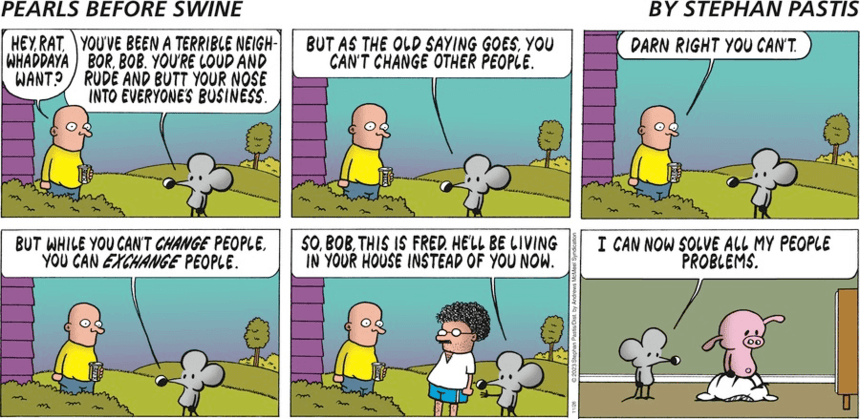
In today’s Pearls Before Swine (AMS) Rat is a bit more proactive than most of us in dealing with neighbor issues, but, then, Rat has never been a model of patience.
I particularly liked the cartoon because I’ve just set a new record, going over 13 years of living in the same house. In both cases, all my immediate neighbors changed over time except one couple in Colorado who were so quiet that it hardly mattered.

Which cancels out the church across the street from my current place, which left in the middle of the night in dramatic fashion.
It’s a good argument for staying in one place, although, as said, it requires patience. I’ve lived in about 20 different places, excluding some college flops, so the fact that I’ve spent 26 of my years in just two of them shows that I’ve pondered the matter from both sides.
Probably also shows how often I was the obnoxious neighbor who moved away.
Juxtaposition of the Day
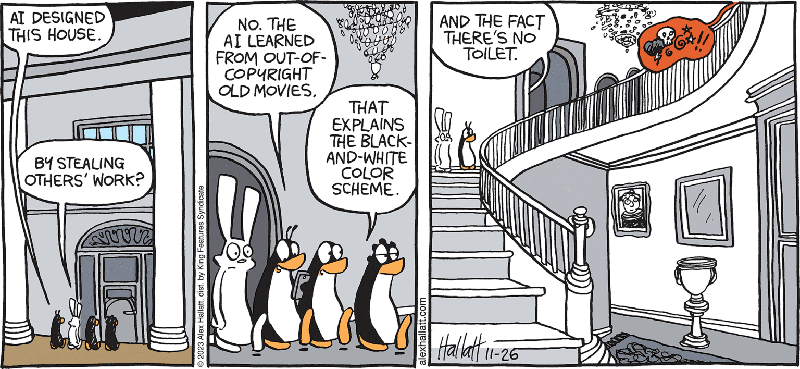
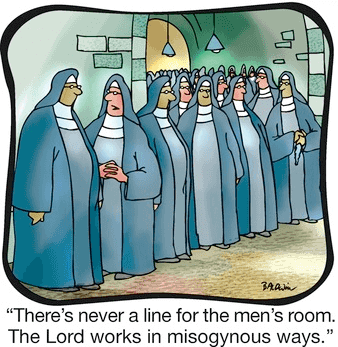
As far as I can recall, Arctic Circle is correct that there were no toilets in old movies, Alex Hallatt being careful to say “toilet” and not “bathroom,” since there were plenty of scenes of people shaving or applying makeup at sinks. But I don’t recall so much as a hint of a water closet in any of those shots.
I use the term “water closet” because that’s what toilets are called in the International Building Code, which brings us to Cornered, because until relatively recently, there was no obligation under the IBC for public buildings to have restrooms for women.
And I use the term “restroom” as a euphemism based on stores at the turn of the 20th century which not only chose to provide facilities for women but fixed them up with couches, suggesting that there were certain times a woman might feel the need to get off her feet as well as to use the water closet.
Yet, as Mike Baldwin’s nun points out, women often find a lack of potty parity, and our leaders are greatly to blame: Pat Schroeder raised the issue as a young Congressional rep back in the early 70s because the Capitol was built with the assumption that no women would need a water closet.
I have no idea what these legislators’ secretarial staff was supposed to do for all those years, though I suppose when it was built, they were mostly male as well.
But times have changed, and the — I kid you not — American Restroom Association has this rundown on the issue of potty parity. It’s all very interesting, but it hasn’t solved the problem of women standing in long lines while men don’t.
The problem is not the code, according to Jennifer Hendricks, a professor at the Colorado University Law School, but hidebound, impractical interpretation of the code by local bureaucrats, and her paper on the topic is a great deal more entertaining than you might expect.
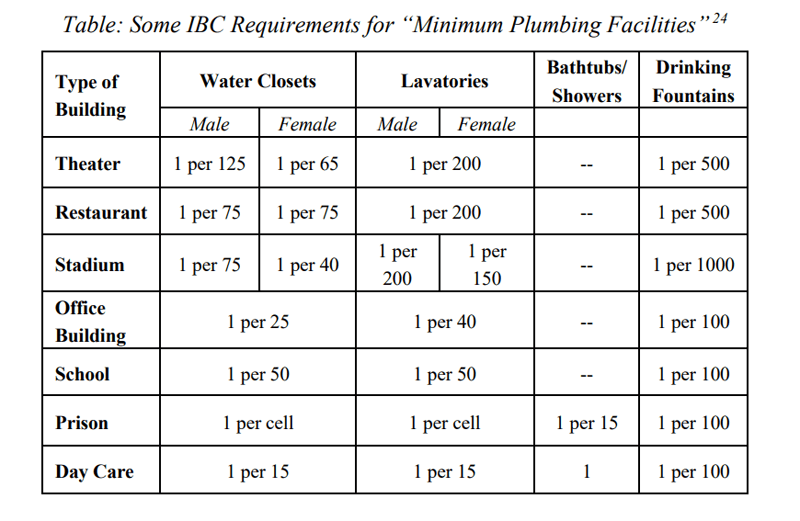
Her main point is that, while the IBC specifies numbers by each sex, it does not require segregation by sex, and unisex facilities would solve not only the lines/no lines issue but issues of gender identity as well.
I’m not sure why she thinks such things should be interpreted sensibly, but she does.
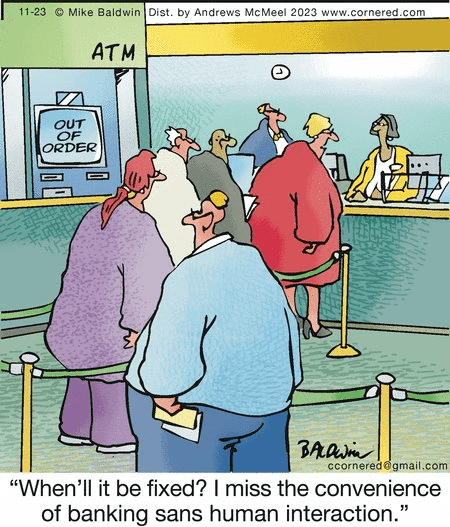
Mike Baldwin was on a hot streak this past week, or at least he was on a streak of hitting my sore spots, and this one landed, as it happens, the morning after a day in which I observed that there were three cars lined up at the teller window in the bank drive-up but nobody at the drive-up ATM.
Which suggests that those people who complain about self-check machines in stores are either in good company (polls suggest they are not) or they prefer waiting in lines to using machines (which I greatly suspect).
BTW, I have often suggested to people who complain about self-check that they (A) stop using ATMs, (B) stop pumping their own gas, and (C) get over themselves.
But I have figured out the solution: Most stores also have a service where they will gather your groceries and bring them out to your car, preserving at least one and probably two jobs. Then the only scary machine involved is the swipe-card reader you’ll use to pay for the groceries, though I suppose they take cash and checks.
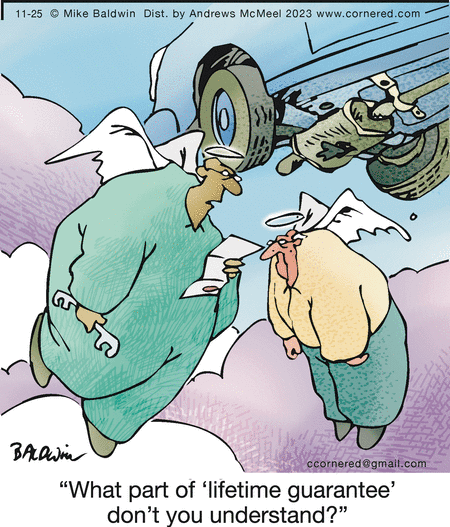
Baldwin goes for the hat trick with the theological question, “Do they have muffler shops in heaven?”
One of the first things young car owners learn is that the lifetime guarantee only covers the muffler itself and none of the expensive pipes, connectors and hangers that invariably are found to also be worn out and requiring replacement.
Which is why I’m pretty sure that, if you see a muffler shop, you didn’t wind up in heaven.
Juxtaposition of Why Some People Deserve to Go to Hell

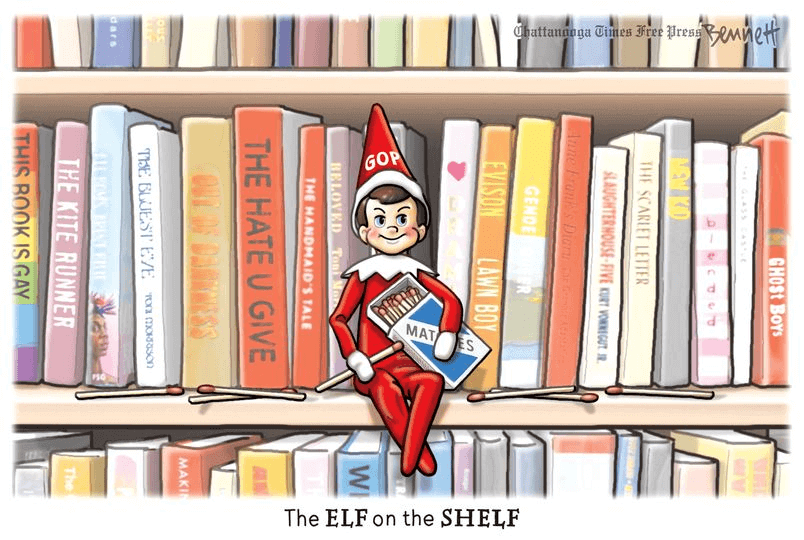
My mother was traumatized when she learned about Santa, less, I think, because she needed him to be real than by the fact that she’d been lied to by people she loved and trusted.
As a result, any questions from us, for instance, about how he could come down the chimney when we didn’t have a fireplace were answered with “Well, what do you think?”
Not only did she let us figure it out for ourselves, but she certainly didn’t use Santa as a threat, and wit all doo respeck to Wanda MacPherson, when you hit that level, you’ve already lost the game.
Elf on the Shelf, though, takes bad parenting to a thermonuclear stage, combining guilt and threats with dishonesty by moving the damn thing around for weeks to create the impression that it’s alive. It’s like filling an Advent calendar with ex-lax.
Which makes me love Clay Bennett’s use of the little monster as a stand-in for the Moms For Hate or whatever they call themselves.
If his cartoon doesn’t make you laugh, read this news story about the rightwing fascisti who, having been voted off their local school board by the decent people, tried to give their superintendent-ally a $700,000 golden parachute, after costing local taxpayers $1.5 million in ridiculous lawsuits.
Boy, has Santa got a load of coal for them!

Do people actually lie to their kids about Santa Claus in real life? I thought that was just in TV and movies because religion’s taboo.
Oh, my, yes:
https://en.wikipedia.org/wiki/Santa_Claus#Controversy_about_deceiving_children
Elf on the Shelf is even worse, promoting a lie that a toy is not only real but was sent to spy on them, and parents move it around at night to reinforce the notion that it’s alive.
https://en.wikipedia.org/wiki/The_Elf_on_the_Shelf#Criticism
Thank you for the link to Prof. Hendricks’ paper. I like her idea of multi-user stalls with doors that go all the way to the floor and don’t have a large gap on either side. What an innovation!
My employer, for reasons including a desire to make transgender people feel welcome, changed a lot of the bathrooms from gender-specific to ones for single users of any gender. This was a good idea, and the bathrooms are now much more accessible for people with disabilities, but it did cut down the number of available water closets and urinals. The nearest men’s room, for example, had one toilet in a stall, one urinal, and two sinks. Now it has one toilet and one sink. The ladies’ room next to it had, I was informed, two water closets and two sinks, replaced by one each. Fortunately, there are six gender-neutral bathrooms and one men’s room within a few minutes’ walk, so most of the time an elderly person such as myself can find a place that his bladder is demanding to use. There are a few trees nearby, but not many and not all that close. Also, the city has an ordinance prohibiting public urination, though if there were more trees it wouldn’t be public, would it?
There is also the problem of restrooms that are single-user but marked for men and women. Years of conditioning have made it very difficult to use a single-user restroom designated for women. I know there’s no reason not to, and I have on occasion, but Back In My Day this was Not Done. My wife has used a single-user men’s room, too. She made sure to leave the seat up when she left.
If you’ve made it this far, you might enjoy Frank Muir’s book “An Irreverent and Almost Complete Social History of the Bathroom.” It’s out of print, but you can find used copies here and there.
When I need roll of quarters for the Laundromat, I have found the local ATM singularly unhelpful. Of course, I could withdraw ten dollars and then seek out a human teller to give me the required coins (The coin exchange at the laundromat is frequently unhelpful too.)
I remember using quarters, before the laundromat installed machines that take cards. My arthritic hands are very grateful.
ATMs are good if you need quick cash or make a quick deposit.
ATMs are far less helpful if you need coins, or any amount of cash that isn’t in exact multiples of 20.
The comic strip, Edge City, by Terry and Patty LaBan, had a sunday strip where at a rock and roll nostalgia show, the men’s lines are all longer than the women’s lines. I can’t say anything about that, but I do know that airports, the men’s lines are just as long, if not longer than the woman’s lines.
And as for ATMs, I get my cash at stores – which means I have to buy something, but since I have no local bank, it’s the best I can do.
I used to rely on change back from a purchase with a debit card at stores to supply my incidental cash needs, but now they’ve started charging for cash back unless it’s $100.00 or more. Furthermore, my bank gives points when I use my card as a credit instead of a debit, and stores won’t give change on a credit card transaction.
We order groceries online, prepay, choose our pickup time slot, park in the reserved spot, text that we have arrived. They come out and load the grub into the SUV rear. Thanks are expressed. They even push the lift gate button to close. No more in-store anxiety for me.
Thank you for the hat trick, Mike, It’s quite an honor!